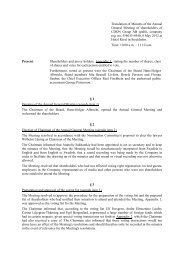Annual Report 2010 - CDON Group
Annual Report 2010 - CDON Group
Annual Report 2010 - CDON Group
Create successful ePaper yourself
Turn your PDF publications into a flip-book with our unique Google optimized e-Paper software.
<strong>CDON</strong> <strong>Group</strong> AB<br />
<strong>Annual</strong> Årsredovisning report <strong>2010</strong> <strong>2010</strong><br />
2.13.2 Intangible assets with defined useful lives<br />
2.13.2.1 Development expenses<br />
Development expenditures for creating new or improved products or processes are recognised as assets in the statement of<br />
financial position if the product or process is technically and commercially viable and the <strong>Group</strong> has sufficient resources to complete<br />
the development. The carrying amount includes direct costs and, where applicable, expenditure for salaries and share of indirect<br />
expenses. Other expenses are recognised in the income statement as expenses when they arise. In the statement of financial<br />
position, recognised expenses are carried at cost, less accumulated amortisation and any impairment losses. Capitalised<br />
expenditures refer mainly to software and software platforms.<br />
2.13.2.2 Domains<br />
Domains are recognised at cost less accumulated amortisation (see below) and any impairment loss (see accounting policy 2.15).<br />
2.13.2.3 Customer relationships<br />
Customer relationships are carried at cost less accumulated amortisation (see below) and any impairment loss (see accounting<br />
policy 2.15).<br />
2.13.3 Amortisation method for intangible assets<br />
Amortisations are recognised in profit/loss for the year on a straight-line basis over the estimated useful life of the intangible asset,<br />
provided such useful life is indefinite. Useful lives are reassessed at least once a year. Goodwill and trademarks with indefinite<br />
useful lives are tested for impairment annually and when there are indications that the asset has lost value. Intangible assets with<br />
determinable useful lives are amortised from the date on which they become available for use. Estimated useful lives:<br />
Development expenses 5 years<br />
Domains 5 years<br />
Customer relationships 4-5 years<br />
2.14 Inventories<br />
Inventories are valued at the lower of cost and net realisable value. Net realisable value is the estimated selling price in the ordinary<br />
course of business less the estimated costs of completion and sale. The cost of inventory is based on weighted averages and<br />
includes expenditures incurred in the acquisition of goods and bringing the goods to their form and location. Provisions for<br />
obsolescence are included in cost of goods sold.<br />
2.15 Impairment losses<br />
The <strong>Group</strong>’s recognised assets are assessed on every reporting date to determine whether indications of impairment exist. IAS 36 is<br />
applied to impairment of assets other than financial assets, which are recognised as per IAS 39.<br />
2.15.1 Impairment of tangible and intangible assets<br />
The recoverable amount of the asset is calculated if there is indication of impairment (see below). The recoverable amount is also<br />
calculated annually for goodwill, trademarks, and intangible assets that are not yet ready for use. If substantially independent cash<br />
flows to an individual asset cannot be established, and if the asset’s fair value less selling expenses cannot be used, then assets are<br />
grouped in impairment testing at the lowest level at which substantially independent cash flows can be identified – this grouping is<br />
called a cash-generating unit (CGU).<br />
59




